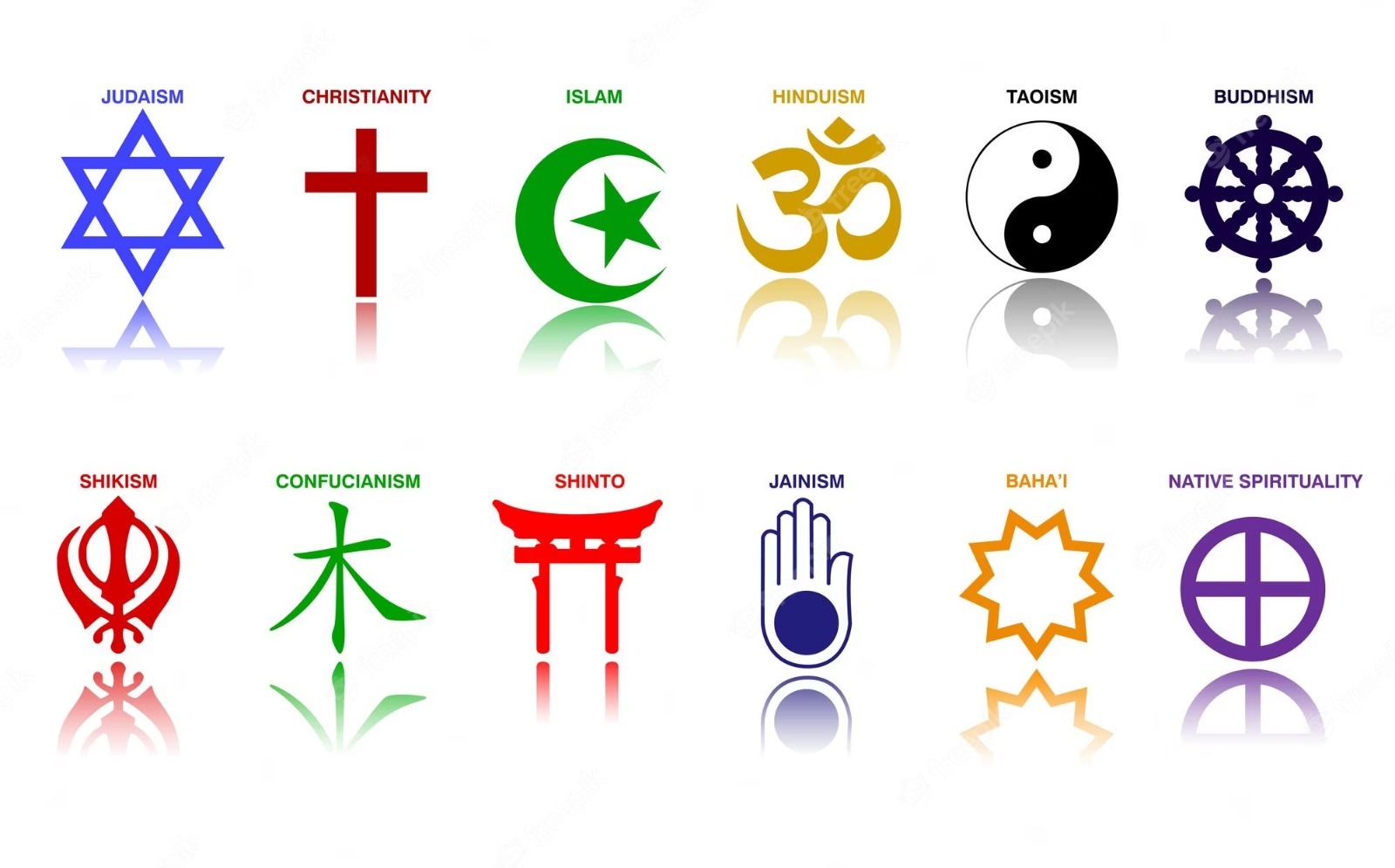A Glance Over
Major Religions of the World
By M. Burhanuddin Qasmi
Director: Markazul Ma’arif Education and Research Centre
Editor: Eastern Crescent, Mumbai
Definition of Religion
There are different definitions of religion but this author considers:
‘A religion is a set of organized beliefs, practices and systems that governs an individual human’s personal as well as public life which is expressed by confession, worship or moral practices, with the belief that there exists a God, gods or ‘super natural being’ who would cause benefit or harm here in this life and grant salvation or impose punishment in the life after death.’
Religion often involves scriptural doctrines, theological beliefs, cultural practices, worldviews, sacred texts, prophecies, revelations, and morals that have spiritual meaning to members of that particular faith, and it can encompass a range of different practices, including prayers, sermons, rituals, meditation, visiting holy places, wearing symbols, attending feasts and joining particular celebrations.
Categorization of Major World Religions
First of all, most religions of the world are broadly categorized into two – Semitic religions and non-Semitic religions. Non-Semitic religions are again divided into two – Aryan religions and non-Aryan religions.
Semitic religions:
Semitic religions are those religions that originated from the Semites. According to Abrahamic religions (Judaism, Christianity and Islam), Prophet Noah (pbuh) had a son called Shem (Hebrew), in Arabic Saam. The descendants of Shem (Saam) are known as Semites.
Therefore, Semitic religions are the religions that are originated from the present West Asian region and have been practiced by the Arabs, Assyrians and Phoenicians, etc. from the time immemorial. Major Semitic religions are Judaism, Christianity and Islam. These three religions including Baha’ism are Monotheistic and Prophetic religions that believe in Divine Guidance sent through prophets of God (Allah). These are also known as the Western religions, Abrahamic religions and Revealed or Heavenly religions.
Non-Semitic religions:
Non-Semitic religions are those which are originated from other than the descendants of Saam (Shem). As stated above that the non-Semitic religions are further subdivided into two – Aryan and non-Aryan religions.
Aryan Religions:
Aryan religions are the religions that are originated from the Aryans. The Aryans had been a powerful group of Indo-European speaking people that spread through present-day Iran, medieval Khurasan and present Northern India in the first half of the second Millennium (2000 to 1500 BC).
The Aryan Religions are further subdivided into two – Vedic and non-Vedic religions.
The Vedic Religion which roots its origin to the Vedas is the Sanatana Dharma (ancient religion), which later got the misnomer of Hinduism or Brahminism. The non-Vedic Aryan Religions are Buddhism, Jainism, Sikhism etc. These all four Aryan Religions including Qadiyanism, if it is called a new religion, are of Indian origin and are among the Eastern Religions.
Almost all Aryan religions are non-Prophetic and largely polytheistic religions, excluding Qadiyanism.
Zoroastrianism (Persism) is an Aryan, non-Vedic old religion which is originated from Iran (Persian speaking people). It claims to be a monotheistic and prophetic religion, considering ‘Zoroaster’ as its prophet.
Non-Aryan Religions:
The non-Aryan religions have two diverse origins. Confucianism and Taoism are of Chinese origin while Shintoism is of Japanese origin. Many of these non-Aryan religions do not have a clear concept of God or detailed scripture. They are better referred to as ethical or social systems rather than as religions. These three non-Aryan religions are also among the Eastern Religions, owning to be originated from out of West Asia.
Precisely, the present geographical West (Europe, America and Australia etc.) has not originated any major world religion ever. All the major religions are from Asia only.
The World’s Major Religions
We would discuss theologically about all the world’s major religions, separately, one by one through different modules for the students of comparative studies of religions. However, the followers or adherents of all 23 ‘recognized religions’ of the world mentioned here below in this module, are current (2023) estimates of the number of people who have at least a minimal level of self-identification as adherents of a particular religion. Valid arguments can be made for different figures, and we do not claim to be cent percent accurate in our statistics. Further details and sources are available online and individual researchers may cross check from open source data or country wise religious statistics. A major source for these estimates is the detailed country-by-country analysis done by ‘David B. Barrett’s’ religious statistics organization, whose data are published in the ‘Encyclopedia Britannica’ (including annual updates and Yearbooks) and also in the ‘World Christian Encyclopedia’, the latest and the 3rd edition of which was published in 2019.
This categorization of religions is not a comprehensive list of all religions, only the “recognized” ones, are included here in this module. There are distinct religions other than the ones listed here but this presentation, we argue, represents the religious affiliation of over 98 percent of the world’s population. There are known religions which are not included in this paper such as – Mandeans, PL Kyodan, Ch’ondogyo, Vodoun, New Age, Seicho-No-Ie, Falun Dafa/Falun Gong, et al. A brief explanations for why, they and some other religions, do not qualify as ‘world’s major religions’ is given at the end of this module.
Statistics and geography citations for religions, which are not in this presentation, as well as subgroups within some major religions such as Catholics, Protestants, Karaites, Wiccans, Shiites, Qadiyanis, etc. can be searched out separately by the interested researchers.
Scale to Categorize World Religions
Recognized Religions are:
- Large – at least 500,000 adherents/ followers
- Active – appreciable numbers of members live and worship in more than just one country or limited region
- Independent – the religion is clearly independent and distinct from a broader religion
- Challenging – the religion challenges one or more theological principals of a world’s major religion or its main scripture and the same is agreed by the vast majority religious scholars of that major religion.
Major Religions are:
There are many distinct religions or religious movements which have more adherents than some of the major world religions, but which are not part of the major list for various reasons. These reasons are:
- The religions which are not included on the major or recognized list are too new (Scientology, Neo-Paganism)
- They are concentrated in only one country (Cao Dai, Ch’ondogyo, Tenrikyo)
- They lack identifiable central organizations or unifying scriptural literature (Neo-Paganism, New Age, Spiritism)
- Their adherents primarily name a different, more established traditional religion as their religious preference (most practitioners of Vodoun are nominal Catholics, practitioners of New Age religions are often nominally Protestant, Catholic or Jewish)
- Their religion is still strongly associated with a major religion from which it arose, but no longer wishes to be an official part of that (Tenrikyo and many other Japanese New Religious Movements, as well as many religions emerging from Indian/Hindu environments)
- The adherents/ followers of that religion do not consider themselves from a separate religion, instead their opponents consider them out of the main religion (Qadiyanism).
As in 2023 CE, the World’s Recognized Religions, as per adherence are:
- Christianity: 2.81 billion
- Islam: 2.05 billion
- Secular/Nonreligious/Agnostic/Atheist: 1.91 billion
- Hinduism: 1.2 billion
- Chinese traditional religion: 394 million
- Buddhism: 506 million
- Primal-indigenous: 300 million
- African Traditional & Diasporic: 100 million
- Sikhism: 26 million
- Juche: 19 million
- Spiritism: 15 million
- Judaism: 14.7 million
- Qadiyani (Ahmadiya) 10 million
- Baha’i: 5 million
- Jainism: 4.2 million
- Shinto: 4 million
- Cao Dai (Taoism): 4 million
- Zoroastrianism: 2.6 million
- Tenrikyo: 2 million
- Neo-Paganism: 1 million
- Unitarian-Universalism: 800 thousand
- Rastafarianism: 600 thousand
- Scientology: 500 thousand
The World’s Popular Religions:
There are twelve popular religions in the world. This is the list of religions described most often in surveys of the subject and are studied in World Religion classes or Theology Studies.
The list is in the alphabetic order:
- Baha’ism
- Buddhism
- Christianity
- Confucianism
- Hinduism
- Islam
- Jainism
- Judaism
- Shintoism
- Sikhism
- Taoism
- Zoroastrianism
During the 18th century comparative religion scholars increasingly recognized Judaism, Christianity, Islam, Hinduism, and Buddhism as the most significant, major and “popular world religions.” Even today, these are considered the “Big Five” and are the religions most likely to be covered in world religion studies almost in all universities of the world.
Five smaller or more localized religions/philosophies brought the list of ‘world major religions’ to ten. Thus, Confucianism, Taoism, Jainism, Sikhism and Zoroastrianism are also listed among the world’s major religions.
Notably, in the beginning of 19th Century only, comparative religion writers in the West began to take note of the Sikhs which had begun to immigrate to England from India (part of British colony at that time). Sikhs, if mentioned at all, had been classified as a sect of Hinduism, influenced by Sufi school of Islam – Muslims had partly or fully ruled in India nearly 800 years, during the first three hundred years of Sikhism.
Baha’is are the most recent entrant to this list. This religion is the latest in the chain of world religion which came into existence in the beginning of 19th century only when Baha’u’llah (1817–1892 CE), claimed to be the prophet like Jesus (pbuh) and Muhammad (saws) in 1863 CE and faced exile and imprisonment for the remaining most of his life. On their official website, Baha’is claim to have 5 million adherents in more than 100 countries and territories throughout the world. While most comparative religion textbooks produced during this century either ignored them or grouped them as a Shiite Muslim sect. Nevertheless, the recent studies give them separate status and often include their chapter. Baha’is have achieved this status partially through their worldwide geographical spread under the political patronage of the West and partially by constantly insisting that they are indeed the “newest world religion,” with their headquarter in Haifa of present-day occupied Palestine or Israel.
Therefore, the ‘major’ set of twelve is not necessarily the most accurate reflection of the present, real-world religious situation. If Baha’is claim to be the followers of the newest religion, an offshoot from Shia Islam, then Qadiyanis (Ahmadiyas) are also considered to be a separate religion by all Muslims worldwide, deviated from Sunni Islam and originated from Indian subcontinent, with the similar believes and same patronage from the West like that of the Baha’is. In the late 19th century, it was founded by Mirza Ghulam Ahmad Qadiyani (1835–1908 CE), who claimed to have been divinely appointed by Allah (swt) as both the promised Mehdi, and Messiah – Isa Maseeh, thus a prophet, in November, 1900 CE. The exact number of Qadiyanis is, though, not known, however, various sources indicate their followers are between 10 to 12 million, spread in more than 50 countries worldwide with the present headquarter at Tilford, England (UK), kipping the spiritual headquarter at Qadiyan, a small township, in the Punjab province of India.
World’s Major Religions Ranked by Internal Similarities
Each of the world’s major religions is actually a classification of multiple distinct movements, sects, divisions, denominations, etc. None of these major world religions is a single, unified, monolithic organization. The diversity within these religions varies. For instance, Hinduism is often described as a collection of very different traditions, bound by a geographical and regional identity. So broad is this religious ‘umbrella’ that it even accommodates contrast ideologies within its fold such as clearly polytheistic, monotheistic, pantheistic, nontheistic and atheistic traditions. On the other hand, Baha’i religion is probably the most unified of the world’s major religions. It is almost entirely contained within one very organized and hierarchical denomination so far with a modern corporate approach. The below listing indicates ranking of world’s major religions as per internal similarities.
Most Unified to Most Diverse:
- Baha’i
- Zoroastrianism
- Sikhism
- Islam
- Jainism
- Judaism
- Taoism
- Shintoism
- Christianity
- Buddhism
- Hinduism
From an academic and comparative religions viewpoint, there is no basis to state whether it is better for a religion to be highly unified, cohesive, monolithic, and lacking in internal religious diversity, or whether it is better to be fragmented, schismatic, diverse, multifaceted and inviting variations on the same theme.
In a practical sense, most people actually practice only one form of whatever religious denomination they belong to. That’s an individual generally follows one particular denomination from with his broad religion at one time. Buddhism, for example, if viewed as a whole, can be understood to have a large amount of internal variation like that of Hinduism, including the Theravada and Mahayana branches, all of their sub-schools, various revivalist sects, as well as Tibetan and modern Western forms but most Buddhists are not actually involved in all of these at one time; rather they practice one school, internally cohesive, fairly unified form within those schools or sects.
How are religious adherents counted in the world?
There are five main methods for determining the number of adherents in a faith group:
- Organizational Reporting:
Religious bodies such as churches, masjids, temples, NGOs or schools etc. are asked how many adherents or members they have. This is the simplest and least expensive method, but it can be highly unreliable. Different faith groups measure membership differently. Some count as members only those who are actively attending services or who have passed through a lengthy initiation process. Others groups count all who have been born in their parent’s faith, even though some of those people may have joined other faith groups as adults. Some groups over-report membership and others under-report membership.
- Census Records:
Many countries periodically conduct a comprehensive house-to-house census, such as in India, after each 10 year, a national census is to be conducted. Religious preference is often a question included in these census counts in most countries of the world. This is a highly reliable method for determining the religious self-identification of a given population. But censuses are usually conducted infrequently. The latest census may be too old to indicate recent trends in religious membership. Also, many countries either have no accurate census data, or do not include questions regarding religious affiliation. It has been over fifty years since the United States included such a question in its national census, but Canada, India, Pakistan, Indonesia, New Zealand, Australia and other countries have very thorough, recent census data on the topic.
- Polls and Surveys:
Statistical sampling using surveys and polls are used to determine affiliation based on religious self-identification. The accuracy of these surveys depends largely on the quality of the study and especially the size of the sample population. Rarely are statistical surveys of religious affiliation done with large enough sample sizes to accurately count the adherents of small minority religious groups.
- Estimates Based on Indirect Data:
Many adherent counts are only obtained by estimates based on indirect data rather than direct questioning or directly from membership role books. Wiccan groups have traditionally been secretive and often their numbers can only be estimated based on magazine circulations, attendance at conferences, etc. The counts of many ethnic-based faith groups such as tribal religions are generally based on the size of associated ethnic groups. Adherents of some tribal religions, such as Yoruba, are sometimes counted simply by counting the members of the tribe and assuming everybody in it, is an adherent of the religion. Such estimates may be highly unreliable.
- Field work:
To count some small groups, or to count the number of adherents of a larger group within a specific geographical area, researchers sometimes do “field work” to count adherents. This is often the only way to count members of small tribal groups or semi-secretive, publicity-shy sects. Field work may involve contacting leaders of congregations and social gatherings etc., conducting interviews with adherents, counting those participating in key activities. However, there is substantial overlap between “estimates” and “field work.”
Religions Not Included in the List of World Religions
The following religions/groups are religions, but have not been included in this list of major religions primarily for one or more of the following reasons:
- They are not a distinct, independent religion, but a branch of a broader religion/category.
- They lack appreciable communities of followers/adherents outside their home country.
- They are too small.
- They do not come under the definition of religion.















eum aut libero magnam similique magni est vero adipisci qui sit voluptatem. illum laboriosam natus voluptatem veniam et. quo molestias praesentium non modi est.
turbine balancing
Turbine Balancing: Understanding the Dynamics
Turbine balancing, a critical process in the industry, ensures that rotating machinery operates smoothly and efficiently. A well-balanced turbine reduces vibration, enhances performance, and prolongs the life of the equipment. The balance of rotating elements can be categorized into two main types: static and dynamic balancing. Understanding the difference between these two types is essential for effective turbine maintenance and operation.
Static vs. Dynamic Balance
Static balance is concerned with the weight distribution of an object when it is not in motion. It involves addressing the center of gravity, which, if unsupported, will cause the heavy side to drop due to gravity. This form of balance is relatively straightforward, usually necessitating weight adjustments at specific points on the rotor.
On the other hand, dynamic balance refers to achieving stability when the rotor is in motion. In dynamic balancing, the focus is on the centrifugal forces generated by rotating mass. Two-plane imbalance occurs here, meaning that the mass distribution is unbalanced across different planes of the rotor, causing vibrations during rotation. It’s vital to recognize and address dynamic imbalances to ensure smooth rotor operation.
Importance of Turbine Balancing
The need for turbine balancing cannot be overstated. An unbalanced turbine can lead to excessive vibrations, which can cause mechanical failures or a premature end to the equipment’s operational life. These vibrations can generate noise, increase wear on components, and lead to costly downtimes. Thus, implementing effective turbine balancing strategies is vital for operational safety and efficiency.
Dynamic Shaft Balancing Procedure
The process of turbine balancing involves several steps, utilizing a portable balancer and vibration analyzer like the Balanset-1A. This device is equipped to measure vibrations in two planes, making it highly versatile for different types of rotors including turbines, fans, and centrifuges.
The initial stage of turbine balancing begins with measuring the vibrations of the rotor while it operates. The data gathered provides a baseline for understanding the level of imbalance. Next, a calibration weight is added to one side of the rotor to assess the changes in vibration. Further adjustments involve relocating the calibration weight, followed by taking additional measurements to refine the balance process.
Finalizing the Balance
After gathering data through the various stages, the vibration analyzer calculates the necessary corrective weights and their precise positions on the rotor. This allows for effective adjustment, ensuring that the rotor’s balance is restored. The installation of these weights is crucial, as their placement and the mass used must be carefully measured to eliminate the detected vibrations post-installation.
Finally, after the corrective weights are applied, the rotor is tested again to confirm that vibration levels are significantly reduced. Success in this stage indicates that the turbine is once again balanced, optimizing its performance and increasing the longevity of the equipment.
Angle Measurement for Weight Installation
A key aspect of effective turbine balancing is the precise measurement of angles for installing corrective weights. The angle must be measured in the direction of the rotor’s rotation to accurately determine where adjustments need to be made. This detailed measurement ensures that corrections are undertaken effectively, contributing to the turbine’s overall balance.
Application Across Industries
Turbine balancing finds applications in various sectors, from power generation to manufacturing. The versatility of tools like the Balanset-1A allows for effective balancing of not just turbines but also other rotating machinery such as fans, augers, and centrifuges, making it an invaluable asset in many industrial settings.
Benefits of Proper Turbine Balancing
Investing in turbine balancing translates to numerous benefits: improved performance, reduced energy consumption, enhanced safety, and decreased maintenance costs. By ensuring that machinery operates free of excessive vibrations, organizations can achieve higher operational efficiency and cost-effectiveness in the long term.
Conclusion
Turbine balancing is a vital process that requires a thorough understanding of both static and dynamic balancing principles. By implementing effective balancing practices, industries can protect their investments in machinery and significantly improve their operational capabilities. Ultimately, prioritizing turbine balancing contributes to safer, more efficient, and longer-lasting equipment operation.
Hello
I hope you are okay!
Thanks for your comment. We found it sound and recommend you to keep writing us your article on this email: taukirrahmani59@gmai.com
I’m not that much of a online reader to be honest
but your sites really nice, keep itt up!
I’ll go ahead and bookmark your site to come back later.
I’m not that muchh of a online reader too be honest but your sites
really nice, keep it up! I’ll go ahead and bookmark your site to
come back later.
Howdy I am so excited I found your web site, I really found you by error,
while I was searching on Aol for something else, Anyhow I am here now
and would just like to say thank you for a tremendous post and a all
round thrilling blog (I also love the theme/design),
I don’t have time to read it all at the moment but I have book-marked it and also added your RSS feeds,
so when I have time I will be back to read much more, Please do
keep up the great job.
Howdy I am so excited I found your web site, I really found you by error, while I was searching on Aol
for something else, Anyhow I am here now and would
just like to say thank you for a tremendous post and a all round thrilling
blog (I also love the theme/design), I don’t
have time to read it all at the moment but I
have book-marked it and also added your RSS feeds, so when I have time I
will be back to read much more, Please do keep up the great job.
Hi there! I’m at work browsing your blog from my new
iphone! Just wanted to say I love reading through your
blog and look forward to all your posts! Keep up the excellent
work!
Hi there! I’m at work browsing your blog from my new iphone!
Just wanted to say I love reading through your blog and
look forward to all your posts! Keep up the excellent work!
It’s amazing to pay a quick visit this web page and reading the views of all colleagues regarding this piece of writing,
while I am also zealous of getting familiarity.
It’s amazing to pay a quick visit this web page and reading the views of all colleagues regarding this piece of writing, while I am also zealous of getting familiarity.
magnificent issues altogether, you simply gained a logo new reader.
What could you suggest about your put up that
you simply made some days ago? Any certain?
Greate post. Keep posting such kind of info on your site.
Im really impressed by it.
Hi there, You have performed a fantastic job. I will definitely
digg it and in my view suggest to my friends.
I’m sure they will be benefited from this web site.
Greate post. Keep posting such kind of info on your site.
Im really impressed by it.
Hi there, You have performed a fantastic job. I will definitely digg it and in my
view suggest to my friends. I’m sure they will be benefited from this web site.
Hi there everyone, it’s my first pay a visit at this web page, and paragraph is in fact fruitful in support of
me, keep up posting such content.
Hi there everyone, it’s my first pay a visit at this
web page, and paragraph is in fact fruitful in support of me,
keep up posting such content.
Unquestionably imagine that that you stated. Your favorite justification seemed to be on the net
the simplest factor to bear in mind of. I say to
you, I certainly get annoyed at the same time as other
people consider worries that they plainly do not
understand about. You managed to hit the nail upon the top as neatly as defined
out the entire thing with no need side-effects , people could take a signal.
Will likely be back to get more. Thanks
Unquestionably imagine that that you stated. Your favourite
justification seemed to be on the net the simplest factor to bear
in mind of. I say to you, I certainly get annoyed at
the same time as other people consider worries that they plainly do not understand about.
You managed to hit the nail upon the top
as neatly as defined out the entire thing with no need side-effects ,
people could take a signal. Will likely be back to get more.
Thanks!
Hello there! This is my 1st comment here so I just wanted to give a quick shout out and tell you I truly enjoy reading through your posts.
Good day! I just would like to give you a big thumbs up for
your excellent information you have got here on this post.
I’ll be coming back to your blog for more soon.
MetaMask Chrome is incredibly convenient. The ability to manage multiple wallets and tokens is invaluable for crypto traders.
If you want to increase your experience simply
keep visiting this web page and be updated with the most recent news update posted here.
Reading your work felt like discovering a new language — one that speaks directly to the heart while still offering intellectual depth.
Unquestionably imagine that that you said. Your favourite justification appeared to be on the web the easiest thing to be mindful of. I say to you, I certainly get irked while people consider worries that they plainly don’t understand about. You controlled to hit the nail upon the top as well as outlined out the whole thing with no need side effect , other people could take a signal. Will probably be again to get more. Thank you
Wonderful site. A lot of helpful information here. I’m sending it to several pals ans additionally sharing in delicious. And certainly, thanks to your effort!